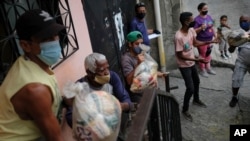A year of rising energy and fuel prices, disruptions from the global pandemic, climate change, and the war in Ukraine, are challenging food prices across the world and in the Western Hemisphere. As a result, many in the Western Hemisphere are experiencing the highest spike in food prices in a generation.
At the Summit of the Americas in Los Angeles, President Biden and partners announced $331 million for humanitarian, food security, and disaster risk reduction assistance.
The number of people facing severe food insecurity in Latin America and the Caribbean doubled from 2014 to 2020 to more than 90 million people. Venezuela’s humanitarian, economic, and political crises have left approximately one-third of Venezuela’s population food-insecure and brought child malnutrition rates to emergency levels, with as many as 50 percent of children under five showing signs of malnutrition.
In Honduras, the World Food Program reported that in late 2021, the number of people facing food insecurity had nearly doubled in just one year, in part due to a pair of devastating hurricanes that hit the region in fall 2020.
The United States is expanding investments that reduce poverty and food shocks in the region, including working with the International Financial Institutions to accelerate the response to food insecurity in areas including supporting vulnerable people; promoting open trade; mitigating fertilizer shortages; supporting food production; and investing in climate-resilient agriculture for the future.
One-third of the world’s food is produced in the Americas, and the current global food crisis is an opportunity and responsibility for the region to step up to supply a greater share of the world’s commodities. The United States will commit to work together to increase food production for export, increase fertilizer production and transportation, and to improve agriculture efficiency through technical solutions and information exchanges.
In addition to $331 million in assistance for food and humanitarian assistance across the hemisphere, the U.S. will help bolster disaster preparedness and response across the region, including by developing early warning systems and providing technical assistance to first responders and community-based risk management groups.
Through USAID partners, the United States continues to prioritize food as well as water and sanitation, shelter, protection services and basic health care for vulnerable populations in Haiti. In Central America, USAID is delivering emergency food, livelihood, and protection assistance, particularly in El Salvador, Honduras, Guatemala.
Advancing Food Security in the Western Hemisphere

A year of rising energy and fuel prices, disruptions from the global pandemic, climate change, and the war in Ukraine, are challenging food prices across the world and in the Western Hemisphere.













